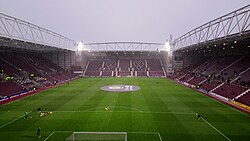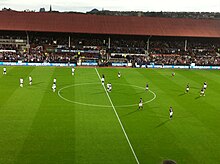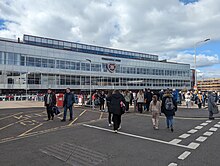Tynecastle Park
Tynie | |
 | |
| Former names | Tynecastle Stadium (c.1996–2017) |
|---|---|
| Location | Gorgie, Edinburgh, Scotland |
| Coordinates | 55°56′21″N 3°13′56″W / 55.93917°N 3.23222°W |
| Owner | Heart of Midlothian F.C. |
| Capacity | 19,852[1][2] |
| Surface | Hybrid |
| Construction | |
| Opened | 10 April 1886 |
| Renovated | 1994–1997, 2017 |
| Architect | Jim Clydesdale[3][4] |
| Tenants | |
| 1886–present | |
Tynecastle Park, also known as Tynecastle Stadium, is a football stadium in the Gorgie area of Edinburgh, which is the home ground of Scottish Professional Football League club Heart of Midlothian (Hearts). A UEFA category four stadium,[5] it has also hosted Scotland international matches, and been used as a neutral venue for Scottish Cup and Scottish League Cup semi-finals.
Tynecastle has a seating capacity of 19,852,[2] which makes it the sixth-largest football stadium in Scotland. Hearts have played at the present site of Tynecastle since 1886.
History
Heart of Midlothian
After
Hearts won the
Redevelopment
Tynecastle underwent substantial changes in the early twentieth century. A small stand and pavilion were built in 1903.
Hearts purchased the ground in 1926.
The terraces were concreted in 1951 and Tynecastle became Scotland's first all-concrete stadium in 1954.
No further changes were made to Tynecastle until stricter ground safety regulations came into effect in the 1970s.[6] Hearts also lacked the finances to redevelop Tynecastle, as the club were relegated from the Premier Division three times in five seasons in the late 1970s and early 1980s.[6] Hearts began to perform better under the ownership of Wallace Mercer, who took control in 1981.[6] The capacity was cut to 29,000 with the installation of benches on the "distillery" covered terrace and in the Main Stand paddock in 1982 and 1985 respectively.[6] Also around this time, lounges and facilities were installed in the Main Stand.[6]
Safety upgrades

The Taylor Report required all major sports grounds to become all-seated by August 1994.[15] Hearts initially entered discussions with Hibernian and the local authorities, but none of the sites suggested were suitable for all parties.[6] In March 1991, Hearts submitted their own proposal for a 30,000 all-seat stadium at Millerhill, in the south-east of Edinburgh.[6] The development would have also incorporated offices, a hotel, supermarket, restaurants and a business park.[6] The site was in the Edinburgh green belt, however, and the proposal was rejected later in 1991.[15] Hermiston was then suggested as a possible site for a new Hearts stadium, but this fell through in December 1992 as it was also within the green belt area.[15]
The collapse of the Hermiston proposal forced Hearts to redevelop Tynecastle instead.[15] In 1994, the entire western and northern sides of the ground were demolished, allowing for the construction of the Wheatfield Stand that year[15] and the Roseburn Stand the following year.[16] Temporary 'bucket' seating was installed on the (southern) Gorgie Road end terracing.[15] That terracing was itself razed in 1997 and replaced by the Gorgie Stand.[17] During this period of redevelopment, the ground was officially renamed as Tynecastle Stadium.[8]
Sale and Hearts ownership
In 2004, then club
The sale was cancelled, however, when
Redevelopment plans
The plans for redevelopment of the main stand were rekindled in December 2015, when Hearts owner Ann Budge said work on the new stand would commence as soon as possible.
Structure and facilities



Tynecastle is an all-seated stadium, split into four sections known as the Gorgie Stand, Main Stand, Wheatfield Stand and Roseburn Stand. The Main Stand was rebuilt in 2017, replacing an older facility designed by noted football stadium architect
Other uses
Other football matches
Tynecastle has been a home venue for the Scotland national football team on nine occasions. It regularly played host to the British Home Championship match with Wales, which was considered to have the least box-office potential and was often played outside Glasgow. After the Second World War, however, the Scottish Football Association favoured playing all home matches at Hampden Park, unless exceptional circumstances prevented Scotland playing there. More recently, Tynecastle has become the home of the Scotland women's national football team.[28]
Tynecastle has been used as a neutral venue for domestic cup semi-finals on numerous occasions, most frequently when these games involve teams from the east or north-east of Scotland (such as Aberdeen, Dundee United or Hibernian). At one stage during the 1920s, Tynecastle hosted a Scottish Cup semi-final in four consecutive years. In total 19 Scottish Cup semi-finals (not including replays) and 11 League Cup semi-finals have been staged at the ground.
However, since the advent of regular live television coverage caused semi-finals to be played at different times, it has been SFA policy to stage both Scottish Cup semi-finals at Hampden, where possible. League Cup semi-finals are still staged at smaller venues depending upon the participants. The last Scottish Cup semi-final hosted at Tynecastle was Aberdeen's defeat of Hibernian in 1992–93. The most recent League Cup semi-final was in 2015–16, when Hibernian won 2–1 against St Johnstone.
Tynecastle was a venue when Scotland hosted the 1989 FIFA U-16 World Championship. Initial group-stage matches were sparsely attended, however, on 20 June 1989, 28,555 spectators watched Scotland defeat a Portugal side containing Rui Costa and Luís Figo 1–0 in the semi-final. Scotland went on to lose the final to Saudi Arabia.
Full internationals
| 26 March 1892 | 1892 British Home Championship | |||
| |
B Lewis |
Attendance: 1,200 Referee: J. Reid (Ireland) |
| 3 March 1906 | 1906 British Home Championship | |||
| W Jones JL Jones |
Attendance: 25,000 Referee: J. Lewis (England) |
| 2 March 1912 | 1912 British Home Championship | |||
Quinn |
Attendance: 31,000 Referee: J. Mason (England) |
| 14 February 1925 | 1925 British Home Championship | |||
| Meiklejohn Gallacher |
Williams |
Attendance: 25,000 Referee: A. Ward (England) |
| 26 October 1932 | 1932 British Home Championship | |||
| Dewar Duncan |
|
Attendance: 31,000 Referee: P. Harper (England) |
| 13 November 1935 | 1935 British Home Championship | |||
| |
Kelly |
Attendance: 30,000 Referee: H. Nattrass (England) |
| 9 November 1938 | 1938 British Home Championship | |||
Walker |
Astley Jones |
Attendance: 34,800 Referee: T.J. Thompson (England) |
| 10 October 1998 | UEFA Euro 2000 qualification | |||
| Dodds Hohlov-Simson |
Report | Hohlov-Simson Smirnov |
Attendance: 16,930 Referee: Marques (Portugal) |
| 27 May 2003 | International Friendly | |||
| Crawford |
Report | Nelsen |
Attendance: 10,016 Referee: Ingvarsson (Sweden) |
Rugby league
The Gorgie ground has also hosted
Music
On 2 August 2019, Tynecastle Park hosted the opening event of the 2019 Edinburgh International Festival.[29] The Los Angeles Philharmonic led by Gustavo Dudamel played a selection of Hollywood film scores, including Jurassic Park, Star Wars, E.T. and Jaws. Over 15,000 free tickets were issued and the concert was live-streamed on Facebook, and broadcast on Classic FM.
Theatre
The
References
- ^ McLean, David (21 June 2017). "Demolition of Tynecastle main stand nears completion". Edinburgh Evening News. Retrieved 6 December 2017.
- ^ a b "Tynecastle Park Safety Certificate, issued October 2018" (PDF). 31 October 2018.
- ^ a b c d "Tynecastle architect says £100,000 to fix stadium". The Scotsman. Johnston Press. 22 December 2004. Retrieved 2 November 2011.
- ^ Anderson, Barry (15 November 2016). "Hearts ready go to work on Tynecastle's new main stand". Edinburgh Evening News. Retrieved 3 December 2017.
- ^ "TYNECASTLE RATED IN TOP UEFA CATEGORY". Hearts of Midlothian. Retrieved 14 October 2023.
- ^ a b c d e f g h i j k l m n o p q r s t u v w x y z aa Inglis 1996, p. 447
- ^ a b c d e f "Tynecastle Stadium: 1874-1891". heartsfc.co.uk. Heart of Midlothian F.C. Archived from the original on 17 February 2012. Retrieved 3 November 2011.
- ^ a b c d e f "Tynecastle Park reinstated". Heart of Midlothian FC. 28 April 2017. Retrieved 28 April 2017.
- ^ a b c d e f "Tynecastle Stadium: 1892-1914". heartsfc.co.uk. Heart of Midlothian F.C. Archived from the original on 17 May 2012. Retrieved 3 November 2011.
- ^ a b "27 April 1895 Hearts 3 Sunderland 5". londonhearts.com. Retrieved 27 April 2013.
- ^ "World Champions!". roker-roar.com. Retrieved 27 April 2013.
- ^ "1902-01-02 Thu Hearts 3 Tottenham Hotspur 1". www.londonhearts.com.
- ^ a b c "Tynecastle Stadium: 1914-1949". heartsfc.co.uk. Heart of Midlothian F.C. Archived from the original on 17 May 2012. Retrieved 3 November 2011.
- ^ a b c d "Tynecastle Stadium: 1950-1980". heartsfc.co.uk. Heart of Midlothian F.C. Archived from the original on 17 May 2012. Retrieved 3 November 2011.
- ^ a b c d e f g h i Inglis 1996, p. 448
- ^ a b c d Inglis 1996, p. 449
- ^ a b c "Tynecastle Stadium: 1981-present". heartsfc.co.uk. Heart of Midlothian F.C. Archived from the original on 16 June 2013. Retrieved 3 November 2011.
- ^ Federation of Hearts Supporters Clubs Archived 16 February 2006 at the Wayback Machine
- ^ "Tynecastle sale to go through, but at what price?". The Scotsman. Johnston Press. 13 September 2004. Retrieved 2 November 2011.
- ^ "Romanov calls off sale of Tynecastle to Cala". The Scotsman. Johnston Press. 22 December 2004. Retrieved 2 November 2011.
- ^ "Hearts to stay at Tynecastle as new stand development stalls". Daily Record. 17 February 2009. Retrieved 2 November 2011.
- ^ "Hearts to stay at Tynecastle and increase capacity of stadium". BBC Sport. BBC. 24 March 2016. Retrieved 3 December 2015.
- ^ Anderson, Barry (15 November 2016). "Hearts ready go to work on Tynecastle's new main stand". Edinburgh Evening News. Retrieved 15 June 2017.
- ^ "Hearts unveil new plans for Gorgie". Edinburgh Evening News. 25 March 2016. Retrieved 24 March 2016.
- ^ "Hearts: Ann Budge backs Ian Cathro and insists Craig Levein does not pick team". BBC Sport. BBC. 13 April 2017. Retrieved 15 April 2017.
- ^ a b "Hearts: SPFL defends late Tynecastle decision as Partick Thistle seek review". BBC Sport. BBC. 20 November 2017. Retrieved 20 November 2017.
- ^ "Hearts v Partick Thistle: Tynecastle deemed safe to host game on Sunday". BBC Sport. BBC. 18 November 2017. Retrieved 19 November 2017.
- ^ "Tynecastle new home of Scotland Women's team". scottishfa.co.uk. Scottish Football Association. 20 September 2011. Retrieved 3 November 2011.
- ^ "Aberdeen Standard Investments Opening Event". Edinburgh International Festival. 29 August 2019. Retrieved 30 August 2019.
- ISSN 0261-3077. Retrieved 27 May 2023.
- ^ "Fringe drama recalling rise and fall of women's football to be staged at Tynecastle". The Scotsman. 30 June 2021. Retrieved 27 May 2023.
- Sources
- Inglis, Simon (1996). Football Grounds of Britain. Collins Willow. ISBN 0-00-218426-5.
- Speed, David; Smith, Bill; Blackwood, Graham (1984). Heart of Midlothian Football Club: A Pictorial History 1874-1984. Heart of Midlothian F.C. plc. (ISBN 0-9510124-1-X).
External links
- Tynecastle Image Archive London Hearts

